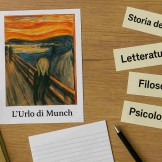SECONDA PROVA LINGUISTICO 2017 TRACCIA DI INGLESE: SVOLGIMENTO
Ormai hai terminato la traccia di seconda prova della Maturità 2017 ed è possibile che al solo pensiero di come è andata stai rabbrividendo. Il momento che ti sembrava lontanissimo è arrivato, l'ansia era tanta e la paura è sempre lì dietro l'angolo: e se sei uno studente del Liceo Linguistico, la tua paura più grande riguarda la difficoltà delle tracce, e avrai di certo dubbi su quale tipologia scegliere e su quale potrebbe essere la più semplice. Noi siamo con te, per cui intanto ecco la soluzione alla traccia di attualità e storico-sociale in inglese, i quesiti e il testo di 300 parole:
- Seconda prova Maturità 2017 linguistico: traccia di attualità
- Seconda prova Maturità 2017 linguistico: traccia storico sociale
- Seconda prova Maturità 2017 linguistico: traccia di letteratura
Inoltre, rispetto agli anni passati, la prova è un po' più complicata, in quanto mentre prima i maturandi potevano decidere la lingua in cui svolgere il compito, adesso invece è il Miur a stabilire la materia.
Quest'anno la decisione è ricaduta su Lingua e cultura straniera 1, vale a dire la prima lingua scelta nella singola scuola. Di conseguenza, la traccia sarà diversa da istituto a istituto, anche se nella maggioranza dei casi la materia che corrisponde a Lingua e cultura straniera 1 è Inglese. E, a tal proposito, abbiamo deciso di fornirvi qui lo svolgimento della traccia di inglese della seconda prova liceo linguistico 2017, in modo che una volta che avrete terminato il compito potrete controllare com'è andata. Dunque, tenete sempre d'occhio questo articolo, in quanto lo aggiorneremo con tutte le notizie fresche fresche riguardanti la traccia ufficiale. Intanto, leggete qui sotto le soluzioni e lo svolgimento della traccia di attualità!
Non perderti:
- Tracce Seconda Prova Linguistico 2017: cosa ricordare per l'orale
- Risposte Seconda Prova 2017: come sfruttare le tracce svolte
Se hai bisogno della traccia di francese non perderti il nostro live:

SECONDA PROVA LICEO LINGUISTICO MATURITÀ 2017 INGLESE: LA TRACCIA
A prescindere dalla lingua in cui si presenterà il compito, la seconda prova del liceo linguistico ha sempre la stessa struttura: ci saranno 4 tipologie di traccia tra cui scegliere e il compito dovrà essere svolto entro 6 ore. Ecco brevemente come si presentano le tracce:
-
Seconda prova liceo linguistico tipologia A, attualità
La Traccia di Tipologia A è composta da un brano di attualità corredato da una serie di domande. Bisognerà poi scrivere un testo di 300 parole sull'argomento affrontato nel testo. Ecco le soluzioni ai quesiti della traccia si attualità:
1. In this article the author talks about poor children he describes the moment in which they enter the school door with a little less than others. They enter with the corrosive effects of poverty.
2. According to NCES data, children in the american public schools are affected by increasing poverty that, obviously, affects their education and future. This situazion may be negative for national progress and it is necessary to be resolved.
3. In the article, american economic situation is described in a detailed way. Poverty among children is underlined talking about theri education and future. There is the will to succeed with determination.
4. Poverty has to be destroyed because it prevents the growth of economy.
5. In the Usa poverty affects the educaton system because it gaves rise to people who won't know, won't study and will become people easy to be conditioned. Education gives people the will to think on their own.
6. Poverty causes misinformation, who is not able to study won't be a free human being.
7. Poverty can be found in different communities in which education is not possible.
8. In this article, the author refers to Southern Education Foundation.
9. Poverty can be addressed founding schools and abolishing disparities.
10. In the last 50 years the issue of poverty has noot been addressed because the priorities have been others, such as economy.Qui il testo di 300 parole:
Poverty is a wide word plague; it exists in all that countries where there is, or there was, exploitation. Africa, for example, is a continent exploited in the past because of natural resources, and today, people suffer of poverty; they have not water, food, medicines. Main victims are children who were born in the wrong country, in a wrong moment. The majority of them will born sick and the possibilities to have a long life are a little few. Unicef, the Pope deal with this problem, but they aren't able to resolve it definetively. According to European Parliament resolution of 24 november 2015, child poverty is a multi dimensional phenomenon that requires a multi dimensional response and it proposes the adoption of a life-cycle approach that reflects the need to early childhood, primary childhood and adolescence. These two approaches could bring different solutions to poverty, they facilitate the attention on a child's life in the every steps of his life, trying to follow their needs. Defining poverty “ a multi dimensional phenomenon that requires a multi dimensional response” is appropriate because this plague can depend of different causes, consequently, it is necessary to act following different solutions. The solution proposed by European Parliament underlines the need to put the child in the center of attention, following him in all his existence phases, guiding him and leaving him when it will be able to afford life difficulties on his own. Guiding children, as possible, gives them the opportunity and the choice to be free. Poverty can be destroyed by putting the forces and, above of all, by education and culture. Somebody who knows and thinks on his own can change the world as possible, he won't be submitted and he will be free to act, to choice and to live.
-
Seconda prova liceo linguistico tipologia B, storico sociale
La Traccia di Tipologia B si basa su un brano di argomento storico-sociale, bisogna leggerlo bene e rispondere alle domande che lo seguono. Successivamente, occorre scrivere un testo di 300 parole sulla tematica affrontata dal brano.
Ecco le risposte ai quesiti:
1. the text gives a foundamental reason in favour of gender parity saying that women are one half of world's population, so they can have the same education and health rights.
2. In China it would be possible to see a gdp increase.
3. The reduction of the gender gap in employment has brought the european economic growth.
4. The measures taken into account are the economic participation, education, health and politics.
5. The world bank finds out that female employement brought an increase in annual gdp.
6. Women are positive in public life, they increase credibility in institutions and democratic outcomes,
7. public life women addresses a business issue.
8. Female talent is well used in business resources, in lackof progression or untapped from the onset.
9. According to the recent world economic forum's future of job survey business leaders note that passing the barriers, new opportunities for growth are guaranteed.
10. Women directors and corporate can better organize needs and concerns. -
Seconda prova liceo linguistico tipologia C, letteratura
La Traccia di Tipologia C consiste in un brano da leggere di letteratura, e anche qui bisogna rispondere ad alcune domande. Successivamente, la traccia chiede di elaborare un testo di 300 parole sulla tematica affrontata nel brano letto.
Ecco le risposte ai quesiti:
1. The narrator of the story is an orphan child, a girl who has two brothers – she’s the middle one – and lives in a village in Africa.
2. The children’s parents are likely dead, even if we don’t know it for sure. Their father was fighting the war and he never come back home; their mother went out to buy some oil for cooking at the shop, but he never come back.
3. The children in the narrator’s family are three: the girl, his older brother and a baby.
4. We don’t know much about the bandits, but we can understand they are a gang of criminals who raided the villages in order to steal all they could find (food, raw materials) and when they didn’t find anything, they burnt the thatch and the roofs of the houses, as well as killed innocent people.
5. The children’s mother repaired the home founding some pieces of tin and putting those up over part of the house.
6. The children cannot tell what day of the week it is because in their village there is no more school or church, points of reference to understand if it is a school day or Sunday.
7. The children’s grandmother is big and strong, not yet old, while their grandfather is small and a bit deaf . The grandmother is the leader as she is the one who takes the children to her place, provides for herself, her husband and the children and she is the one who makes decisions, including leaving the village.
8.The children are very hungry because there is quite nothing left to eat. In the story, the narrator says that they drunk some milk from a woman’s breasts as food or that they should go out to look for wild spinach, but there wasn’t a leaf left.
9. The children’s grandfather cannot farm for food any longer because the bandits took the three sheep and the cow he owned and when planting time came he had no seed to plant.
10. For the children, “away” represents any other place where there is peace and food and no bandits, where they can live peacefully without suffering starvation and feeling constant fear of death.
Ecco la prima produzione scritta di 300 parole:
The use of first person narrator is usually chosen by an author when he/she wants to tell a story from a particular point of view, mainly focusing on the way the events are seen and lived by the narrator instead of having a more objective and general observation of what every character does or thinks. Writers use first person narrator in order to tell just one side of story, or to deepen the psychological portrait of the character/narrator so we can feel his/her feelings, emotions, reasoning, thoughts, points of view as well as discovering what happens little by little.Particularly, in the short story The Ultimate Safari, Nadine Gordimer chose a little girl as a first-person narrator, who has an eldest brother and a younger brother, and whose parents are likely dead. The use of first person narrator is very effective because the reader can feel the pain, the fear and the nightmare this child is experiencing. Using simple words, according to the little girl’s knowledge of the language, she describes the cruel reality surrounding her, the brutality and the difficulties of her childhood. It is also easy to understand the people she is fond of and that makes her feel safe and the hopes she has to find a better place to live.
Another example of first person narrator who conveys the same powerful message is To Kill a Mockingbird, the famous novel by Harper Lee published in 1960. In this case, too, the first person narrator is a girl whose father, a lawyer, defends a black man accused of raping a white woman. Harper Lee combines the narrator’s point of view when she is a child observing her surroundings with her point of view as a grown up woman who reflects on her childhood. This narrative method allows Lee to tell a story mixing the simplicity of childhood observation with adult situations.
Ecco la seconda produzione scritta di inglese letteratura di 300 parole:
Nadine Gordimer, in her short story The Ultimate Safari, tells the story of a little girl and her family: they live in a poor village of South Africa where they suffer starvation and live under constant threat of dying because of the bandits who raid the villages and kill people. The author writes about the appalling conditions of children in South Africa during apartheid as they grow up living without food and education, often without families (the little girl and her brothers’ parents are believed to be dead or lost). They have been experiencing brutality since they were born because they are afraid of bandits who destroy villages, steal food and kill people.In the midst of misery and violence, though, Nadine wants also to convey a message of hope and love: the children are not lost, they can count on their grandparents and there is still hope for them to escape and find a better new place to live happily. Charles Dickens was another novelist who denounced children’s bad conditions in Victorian society. In his famous novel Oliver Twist, Dickens tells the story of an orphan, Oliver Twist, who grows up in a workhouse where the children are exploited, suffer starvation and work hard, while their masters, belonging to the upper class, are wealthy, fat and well-fed.
Throughout the novel, Charles Dickens describes the bad conditions of poor children, forced either to be exploited in workhouses or to become criminals. He also points out the hypocrisy of the Victorian upper class, who hides behind Christian values, strict moral codes and prejudices, but who seems to ignore the way they treat the poorest ones, including children. However, there are also good men and women in Dickens’s perspective: Oliver Twist, at the end of the novel, is adopted and lives happily ever after.
-
Seconda prova liceo linguistico tipologia D, artistico
Il brano presente nella Traccia di Tipologia D riguarda l'arte, occorre leggerlo e rispondere alle domande che ne guidano la comprensione. Successivamente bisogna sviluppare un testo di 300 parole sull'argomento affrontato dal brano.
Scopri come viene valutata la prova: Seconda prova linguistico: i criteri di valutazione
TRACCIA DI INGLESE SVOLTA SECONDA PROVA LINGUISTICO MATURITÀ 2017
Bene, per il momento questo è tutto, ma ricordate di tenere sempre sotto controllo questo articolo, in quanto vi daremo notizie live sulle tracce ufficiali e soprattutto vi forniremo, non appena possibile, lo svolgimento della seconda prova del linguistico. Nel frattempo, ricordate di allenarvi il più possibile come le prove degli anni precedenti, ripassate bene la grammatica e leggete testi in inglese, così da diventare più veloci nella comprensione e acquisire più termini. Durante la prova, leggete tutto con calma, scegliete la traccia che vi ispira di più e cominciate… Infine, riguardate bene e controllate eventuali errori, dopodiché potete consegnare!
Sfrutta gli ultimi giorni per allenarti con le simulazioni:
Se hai bisogno di informazioni o consigli per la maturità iscriviti al gruppo: Maturità 2017: #esamenontitemo








